Pheasant's Tears
by
Kathy Sullivan
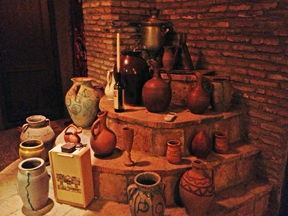 Summary: Pheasant’s Tears’ winery is owned by John Wurdeman an American who became enthused with the Georgian culture after visiting the country. Today John has vineyards, a winery and restaurant in Georgia. The restaurant has several rooms, filled with artifacts and a marani.
Summary: Pheasant’s Tears’ winery is owned by John Wurdeman an American who became enthused with the Georgian culture after visiting the country. Today John has vineyards, a winery and restaurant in Georgia. The restaurant has several rooms, filled with artifacts and a marani.
John Wurdeman, with a degree in art, came to Georgia because of polyphonic music; he is also a traditional artist. The story is told that John was in a vineyard painting when a man approached and asked him to dinner. When John asked why he would invite a complete stranger to his home for dinner, the man responded, “These are my vineyards. I am passionate about these vines. Obviously for you (John) to be painting the vineyards, you also see the beauty of the vines.”
While in Georgia John became enthralled with the Georgian culture and interested in traditional Georgia grapes and qvevri making. While talking with John, he noted that cultural baggage often interferes with people trying other wines.
Pheasant’s Tears may seem like an unlikely name for a winery but in the Kekheti region, it means a great deal to Georgians. According to a local saying, “You can make wine so good you can make a pheasant cry.” Thus the name of the winery is Pheasant’s Tears.
John’s winery is a short distance from the remote but delightful mountain town of Signagi. The small village has been renovated and offers scenic views for visitors. John also owns a restaurant where the chef is from Signagi. Pheasant’s Tears' wine tastings can take place at the winery. Pheasant’s Tears produces 45,000 bottles.
Vineyards
Pheasant’s Tears has 28 hectares of Kisi, Rkatsiteli, Saperavi, Shakapito and Tavkveri. Pheasant’s Tears is also home to a vineyard library with 200 grape varieties. John has made one wine using 80 varieties together.
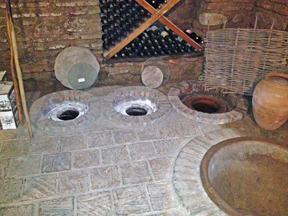 Restaurant Wine Cellar
Restaurant Wine Cellar
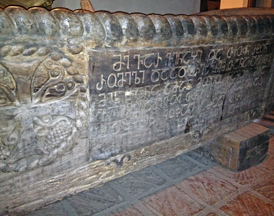 Below the Pheasant’s Tears restaurant is a brick-lined cellar. Brick arches add to the ambiance of the cellar. There are several qvevri buried under the stone floor as seen from the circles in the floor marking the opening of the qvevris. There are several rooms that make up the restaurant. One room houses many of John’s paintings. Throughout the restaurant there are many artifacts. One is a beautifully decorated wood wine press.
Below the Pheasant’s Tears restaurant is a brick-lined cellar. Brick arches add to the ambiance of the cellar. There are several qvevri buried under the stone floor as seen from the circles in the floor marking the opening of the qvevris. There are several rooms that make up the restaurant. One room houses many of John’s paintings. Throughout the restaurant there are many artifacts. One is a beautifully decorated wood wine press.
The restaurant is located in a quaint historic area. The buildings are close together. Inside, the Pheasant’s Tears restaurant is filled with several tables, lights, conversation and conviviality. This is a restaurant where people gather and enjoy Georgian cuisine and Georgian wines from Pheasant’s Tears. We met in the restaurant for a wine tasting and dinner.
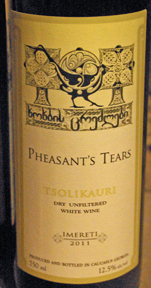 Wines
Wines
Tsolikaure 2012 was produced from Imereti vineyard grapes. The wine was made with limited skin contact during fermentation. The color was a light gold with an orange hue. The wine had floral notes and a slight hint of honey. The finish was crisp. Kisi 2012 was made in qvevri. The wine was on skins for three months. The wine was gold with an orange hue. The wine had a floral aroma and bold tannins on the finish. Tibaani 2012 was named for the vineyard. The wine had 80 varieties of Georgian grapes in it. The color was amber with an orange hue. The aroma with floral notes was reminiscent of a bouquet of flowers. The taste offered notes of roses and daisies. The finish had bold chewy tannins.
Tavkveri 2011 was a dark ruby color. The aroma was of cherry and blackberries. The finish had bold tannins and was fruity. Saperavi 2011 was a black wine. The wine had one month of skin contact. The color was a dark purple to black. The wine offered dark fruit notes including blackberries and black cherry. The finish was fruity with bold tannins. Shavkapito was purple. The aroma was of dark fruits with a taste of blackberries and plums. Tannins accompanied the fruity finish.
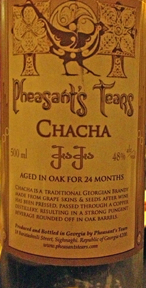 Chacha
Chacha
It was at Pheasant’s Tears where we learned an old legend for drinking Chacha. God and the devil were having an argument. God said that a person that drinks three glasses of Chacha belongs to Him and the devil can have the people that drink four or more glasses of Chacha. The Georgians figured away around this rule. They drink the Chacha quickly in one gulp before the devil knows the number of drinks.
The Pheasant’s Tears’ Chacha was aged in oak for 24 months. This yellow Chacha had notes of alcohol but this Chacha had lower alcohol than most Chachas. The aftertaste was warming with sweet vanilla nuances.
Enjoy a visit to Pheasant’s Tears restaurant and wine cellar. While visiting the village of Signagi take time to explore the historical buildings and enjoy the scenic views.
Pheasant’s Tears
18 Baratashvili St
4200 Signagi, Kekheti, Georgia
